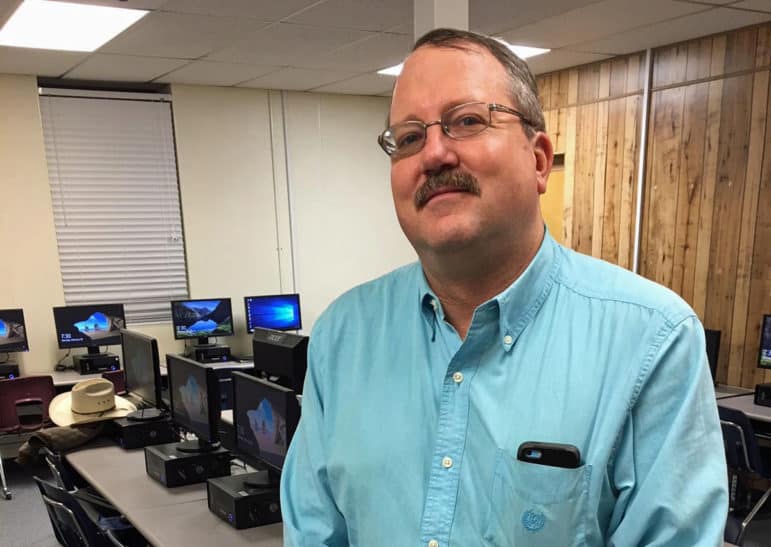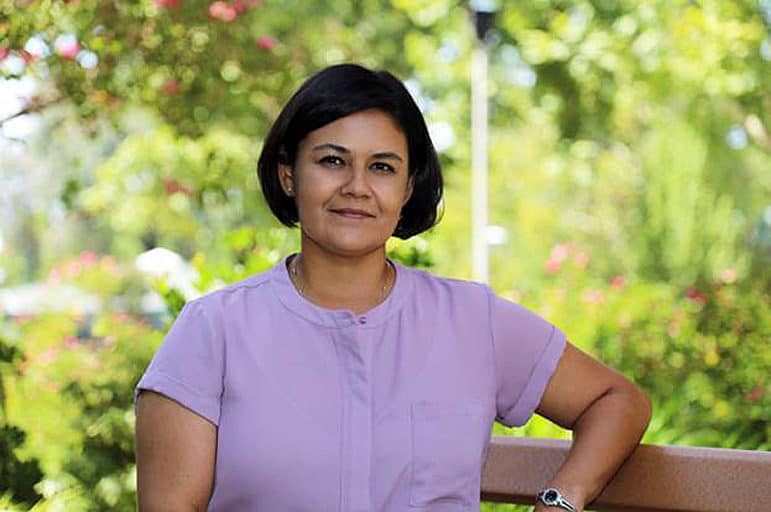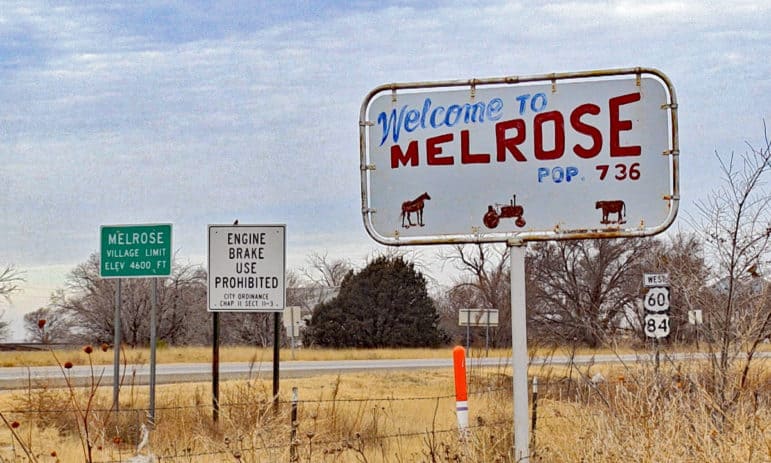In New Mexico, computer science courses are not mandated by the state. Many schools in metropolitan areas offer these courses, but few rural school districts do. However, one rural school district has turned to New Mexico’s Supercomputing Challenge to offer computer science education.
The Village of Melrose may be small, but that hasn’t stopped the school district from competing in New Mexico’s Supercomputing Challenge.
For nearly a year, teams of students here in grades 6 through 12 have met after school to take part in a challenge, trying to solve problems using computational thinking.
After school on a Monday night, sisters Lily and Heidi Macfarlane, along with their 6th grade classmate Eojhan Knight, review comments from a recent presentation of their project that they say could help crop dusters improve safety and efficiency.
These students had to understand how to use a program to write code to solve problems which for some students like Lily Macfarlane took time.
“We had no idea what to do for the NetLogo and that was just the start of it,” she said. “We had to do the codes, and we had to make a model for it on the computer. I didn’t even know how to operate a computer and that was pretty weird cause I’m in this grade.”
Macfarlane says understanding how to code and learn computational thinking was just like getting to know people.
“You know how you make a new best friend, then you finally see what they’re thinking and what they might think,” she said. “It’s kind of like that with a computer.”
For over 16 years, the Melrose Municipal Schools have set aside funding and students have worked concessions to be able to pay for teams taking part in the challenge. Nearly a decade ago, a Melrose team even won the state competition. It was a big win for a school district that doesn’t offer computer science classes. This after-school activity is pretty much their only option, according to Superintendent Jaime Widner.
“We don’t have a computer science class per se, but our science teacher takes care of that, Alan Daugherty, and kids get an opportunity to code and program computers based on something that they see a need for, and it gives them the opportunity to see things that they wouldn’t get if he didn’t do that program,” Widner said.

KRWG photo
Melrose science teacher Alan Daugherty works after school with students competing in the Supercomputing Challenge.
After a full day of teaching science classes to middle and high schoolers and driving bus routes, Daugherty, or “Mr. D” as he’s referred to, returns to school to help Melrose students in the Supercomputing Challenge. Daugherty says he took computer science courses while in college at New Mexico State University. But to help prepare students for the competition, he also completed Supercomputing Challenge training and took advantage of the University of New Mexico’s career development program “CS For All.”
“It’s given them the chance for our kids to get some entry-level computer science skills, and that’s something that we wouldn’t be able to offer here otherwise,” Daugherty said.
During the last 10 years, jobs in computer science have grown in the United States. A 2017 Department of Labor Statistics report showed that 3.9 million people were employed in the industry in 2015, up from 3.2 million in 2009.
To help prepare students to fill these jobs, some states have unveiled more computer science learning opportunities in schools. However, New Mexico does not have an official state plan for K-12 computer science standards. It does not require high schools to offer CS courses or mandate that students can take CS courses for math or science credit. States nearby, like Colorado, are working to adopt computer science standards, and Texas requires that all high schools offer computer science classes.
So, does this Supercomputing Challenge help fill voids that exist in New Mexico when it comes to computer science education? Challenge Director David Kratzer says it can help fill that void, and also works to provide various outreach programs to a younger group of students to address the wide gender gap in computer science jobs.
“We realized that we need to get kids interested at 3rd, 4th, 5th grade level and then we won’t have this disparity in our gender gap,” Kratzer said.
Kratzer says over 11,000 students have participated in the challenge, and many of them have received scholarships to college and have gone on to successful careers. He said in 2003, he did an analysis at Los Alamos National Labs and found that 100 employees were Challenge alumni out of around 10,000.

Courtesy photo
Marisol Gamboa from Salem, N.M. is a computer scientist in the Global Security Directorate at Lawrence Livermore National Laboratory.
Students from rural communities have used the Challenge to find success. Marisol Gamboa is the oldest child of immigrants from Salem, N.M. She’s a computer scientist and division leader at a National Lab in California. She has over 17 years of experience in her field. While attending Hatch Valley Public Schools in the early 1990s, Gamboa was encouraged by a teacher to take part in the Challenge. Her school didn’t even own a computer then, she said, and had to log in from a “Dummy terminal” to a supercomputer at Los Alamos to work on their project.
“I absolutely would not have had any exposure to computers until I would have been in college,” Gamboa said.
Gamboa said her successful participation with the Challenge helped her land multiple scholarships to the University of New Mexico. She says her scholarship funding was large enough to even cover her younger sister’s tuition for a couple of years. She was also able to help her parents buy a larger home with the starting salary she was making at IBM a couple of years after graduation. Many of her siblings went on to higher education and careers.
However, Gamboa said the Challenge is not a panacea for the lack of computer science opportunities in rural areas due to the high poverty rate across New Mexico.
“Extracurricular programs like New Mexico Supercomputer (Challenge) cannot fill the gap due to most students not participating in those programs because they are out helping support their families,” she said.
In Melrose, scholarship help has kept students attracted to the program. Daugherty said every senior who completes the supercomputing challenge has received a college scholarship.
“Essentially all of my seniors that have gone through the program have got some scholarship help, ranging from $500 to $1,000 up to several thousands of dollars each,” he said.

KRWG photo
A sign welcoming people to Melrose, N.M.
As long as students want to take part in the challenge, Daugherty said he’s willing to take the time to do what he can to help.
“In the little schools it always seems there’s a whole lot to do and not a whole lot of people to do it,” he said. “So everyone has to chip in and do what they can.”
With the help of the program and “Mr. D,” these kids in this small village of just over 700 people will see if their projects find success in the Supercomputing Challenge — an experience that may lead to college and building a career in the field.